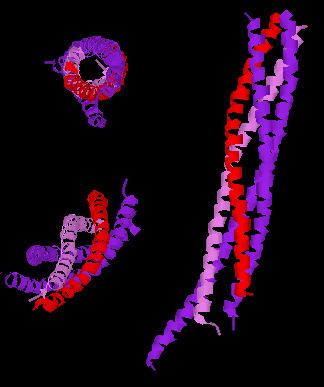Symbol Synaptobrevin InterPro IPR001388 SCOP 1sfc | Pfam PF00957 PROSITE PDOC00368 SUPERFAMILY 1sfc | |
 | ||
Synaptobrevins (synaptobrevin isotypes 1-2) are small integral membrane proteins of secretory vesicles with molecular weight of 18 kilodalton (kDa) that are part of the vesicle-associated membrane protein (VAMP) family.
Contents
Synaptobrevin is one of the SNARE proteins involved in formation of the SNARE complexes.
Structure
Out of four α-helices of the core SNARE complex one is contributed by synaptobrevin, one by syntaxin, and two by SNAP-25 (in neurons).
Function
SNARE proteins are the key components of the molecular machinery that drives fusion of membranes in exocytosis. Their function however is subject to fine-tuning by various regulatory proteins collectively referred to as SNARE masters.
Classification
In the Q/R nomenclature for organizing SNARE proteins, VAMP/synaptobrevin family members are classified as R-SNAREs, so named for the presence of an arginine at a specific location within the primary sequence of the protein (as opposed to the SNAREs of the target membrane, which contain a glutamine and are so named Q-SNAREs). Synaptobrevin is classified as a V-SNARE in the V/T nomenclature, an alternative classification scheme in which SNAREs are classified as V-SNAREs and T-SNAREs for their localization to vesicles and target membranes, respectively.
Clinical significance
Synaptobrevin is degraded by tetanospasmin, a protein derived from the bacterium Clostridium tetani, which causes tetanus. A related bacterium, Clostridium botulinum, produces botulinum toxin that also hydrolyzes synaptobrevin.
Human proteins containing this domain
SEC22A; SEC22B; SYBL1; VAMP1; VAMP2; VAMP3; VAMP4; VAMP5; VAMP8; YKT6;
